
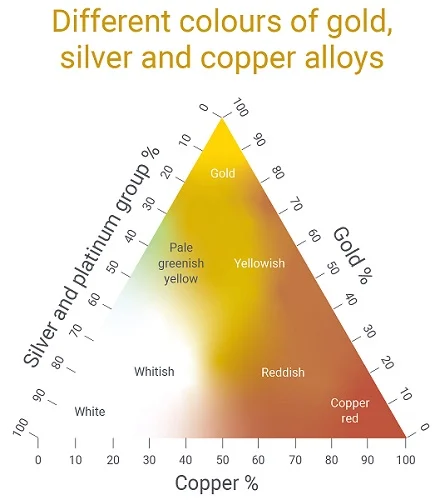
Pure gold softness necessitates alloying with other metals to enhance durability . The 3 gold alloys comparison: yellow , white , and rose gold are imp.
1. Composition and Alloying
- Yellow Gold: Traditional yellow gold is an alloy of pure gold with metals like copper and silver. This combination retains the classic golden hue while improving strength. For instance, 18K yellow gold typically comprises 75% gold, 12.5% copper, and 12.5% silver.
- White Gold: White gold is created by alloying gold with white metals such as nickel, palladium, or silver. To achieve a lustrous white finish, white gold is often plated with rhodium, a platinum-group metal that enhances its appearance and adds a layer of protection. A common composition for 18K white gold includes 75% gold and 25% white metals.
- Rose Gold: Rose gold’s distinctive pinkish hue results from a higher copper content in the alloy, with silver added to balance the color. An example composition for 18K rose gold is 75% gold, 22.5% copper, and 2.5% silver.
2. Purity Levels
Gold purity is measured in karats (K), with 24K representing pure gold. Alloyed gold variants are available in various karatages, affecting both color intensity and durability:
- 18K Gold: Contains 75% pure gold and 25% other metals.
- 14K Gold: Comprises 58.3% pure gold and 41.7% alloyed metals.
- 10K Gold: Includes 41.7% pure gold and 58.3% other metals.
Higher karatages offer richer color and higher gold content but may be softer, while lower karatages provide increased durability due to a greater proportion of alloyed metals.
3. Market Demand and Customer Preferences
- Yellow Gold: Esteemed for its timeless appeal, yellow gold remains a favorite for traditional jewelry pieces, including wedding bands and heirlooms. Its warm hue is often associated with classic elegance and luxury.
- White Gold: Valued for its modern and versatile appearance, white gold has gained popularity, especially in engagement rings and contemporary designs. Its neutral tone complements a wide range of gemstones and outfits.
- Rose Gold: Rose gold has experienced a resurgence in popularity, particularly among younger consumers seeking unique and romantic jewelry options. Its distinctive color offers a vintage charm that appeals to modern aesthetics.
4. Aesthetic Appeal
- Yellow Gold: Exudes a warm, rich glow that enhances traditional and vintage-inspired designs. Its classic appearance makes it a staple in fine jewelry.
- White Gold: Provides a sleek, contemporary look that pairs well with diamonds and colored gemstones, enhancing their brilliance. Its reflective quality offers a sophisticated and elegant appeal.
- Rose Gold: Offers a soft, romantic blush tone that flatters various skin tones. Its unique color adds a touch of individuality and elegance to jewelry pieces.
5. Durability and Maintenance
- Yellow Gold: While higher karat yellow gold is softer and more prone to scratches, lower karat options with increased alloy content offer enhanced durability. Regular polishing can maintain its luster.
- White Gold: The addition of harder white metals and rhodium plating increases white gold’s durability and scratch resistance. However, rhodium plating may wear over time, necessitating periodic re-plating to maintain its appearance.
- Rose Gold: The substantial copper content in rose gold contributes to its strength, making it more durable and resistant to scratches compared to yellow and white gold. It also tends to develop a patina over time, adding to its vintage appeal.
6. Design Trends and Popularity
- Yellow Gold: Continues to be favored in traditional and vintage-inspired designs, with a resurgence in popularity for bold and intricate pieces. Its classic appeal ensures its presence in both contemporary and heirloom jewelry.
- White Gold: Dominates modern and minimalist designs, often used in engagement rings and settings that emphasize gemstone brilliance. Its neutral color complements a variety of styles and is a popular choice for those seeking a contemporary aesthetic.
- Rose Gold: Experiencing a surge in popularity, especially in fashion-forward and alternative designs. Its romantic hue is often featured in mixed-metal pieces and unique, personalized jewelry.
7. Global Popularity
- Asia: Yellow gold holds significant cultural and financial value, particularly in countries like India and China, where it is associated with prosperity and tradition.
- North America: White gold is prevalent, especially in bridal jewelry, due to its modern appearance and versatility.
- Europe: Preferences vary, with a balanced appreciation for all three gold types. Rose gold has gained traction in recent years, aligning with fashion trends favoring unique and personalized jewelry.
- Australia: Rose gold has seen increased popularity, appealing to consumers seeking distinctive and fashionable jewelry options.

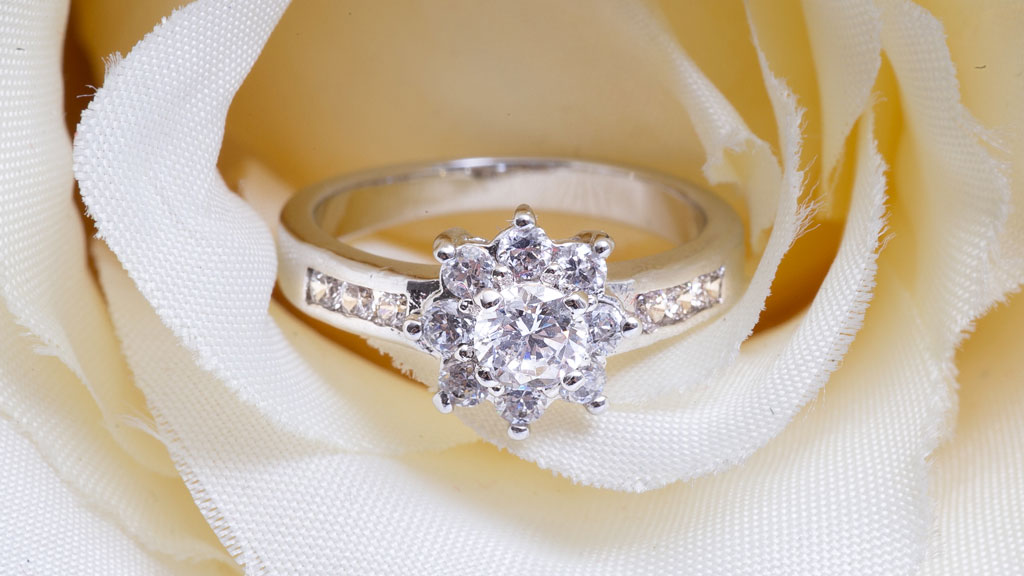
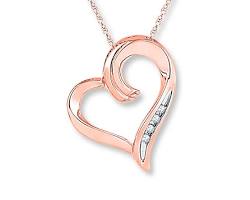
3 Gold alloys comparison in detail
Gold’s versatility and allure are enhanced by alloying it with various metals, resulting in distinct colors such as yellow, white, and rose. Each type has a unique composition that influences its color, durability, and suitability for different jewelry designs.
Yellow Gold:
Yellow gold maintains the classic gold appearance and is created by alloying pure gold with metals like silver, copper, and zinc. The specific composition can vary, but a common alloy for 18K yellow gold includes:
- Gold (Au): 75%
- Silver (Ag): 12.5%
- Copper (Cu): 12.5%
This combination retains the warm yellow hue while enhancing the metal’s strength and durability.
White Gold:
White gold is achieved by mixing pure gold with white metals such as nickel, palladium, or silver, resulting in a silvery-white appearance. A typical composition for 18K white gold might be:
- Gold (Au): 75%
- Nickel (Ni): 10%
- Copper (Cu): 10%
- Zinc (Zn): 5%
To enhance its whiteness and provide a reflective surface, white gold jewelry is often plated with rhodium.
Rose Gold:
Rose gold’s distinctive pinkish hue is achieved by alloying gold with a higher proportion of copper, along with silver. An example composition for 18K rose gold includes:
- Gold (Au): 75%
- Copper (Cu): 22.5%
- Silver (Ag): 2.5%
The increased copper content imparts the characteristic rosy tint to the gold.
These compositions can vary slightly depending on the manufacturer and desired properties of the gold alloy.
For a visual representation, here’s a chart illustrating the typical alloy compositions of 18K yellow, white, and rose gold:
| Gold Type | Gold (Au) | Silver (Ag) | Copper (Cu) | Nickel (Ni) | Zinc (Zn) | Palladium (Pd) |
|---|---|---|---|---|---|---|
| Yellow Gold | 75% | 12.5% | 12.5% | – | – | – |
| White Gold | 75% | – | 10% | 10% | 5% | – |
| Rose Gold | 75% | 2.5% | 22.5% | – | – | – |
Gold, a precious metal prized for its beauty, durability, and value, comes in a variety of colors beyond the traditional yellow. These colors, achieved through alloying, offer a spectrum of choices for jewelry and other applications. This discussion will delve into the characteristics, composition, and comparative aspects of the three most popular gold colors: yellow, white, and rose.
Yellow Gold: The Classic Choice
Yellow gold, the purest form of gold, is an alloy of pure gold and other metals like copper, silver, and zinc. The proportion of these alloying metals determines the karat of the gold, with 24K being pure gold. Common karats for yellow gold jewelry include 18K, 14K, and 10K.
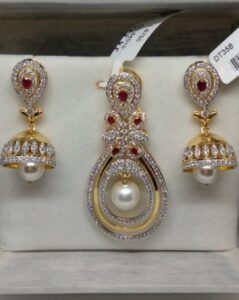
Yellow Gold Jewelry
Characteristics:
- Color: A warm, rich yellow hue.
- Durability: Relatively soft, making it susceptible to scratches and dents.
- Versatility: Pairs well with various gemstones and styles.
- Maintenance: Requires occasional polishing to maintain its luster.
White Gold: A Modern Alternative
White gold is an alloy of gold and white metals like nickel, palladium, or platinum. The addition of these metals masks the yellow color of gold, resulting in a silvery-white appearance.
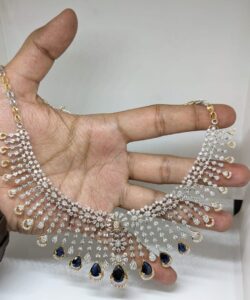
White Gold Jewelry
Characteristics:
- Color: A cool, silvery-white color.
- Durability: More durable than yellow gold due to the addition of stronger metals.
- Versatility: Popular choice for contemporary and minimalist designs.
- Maintenance: Often rhodium-plated to enhance its luster and prevent tarnishing.
Rose Gold: A Romantic Touch
Rose gold, also known as pink gold or red gold, is an alloy of gold and copper. The copper content imparts the distinctive pinkish hue.
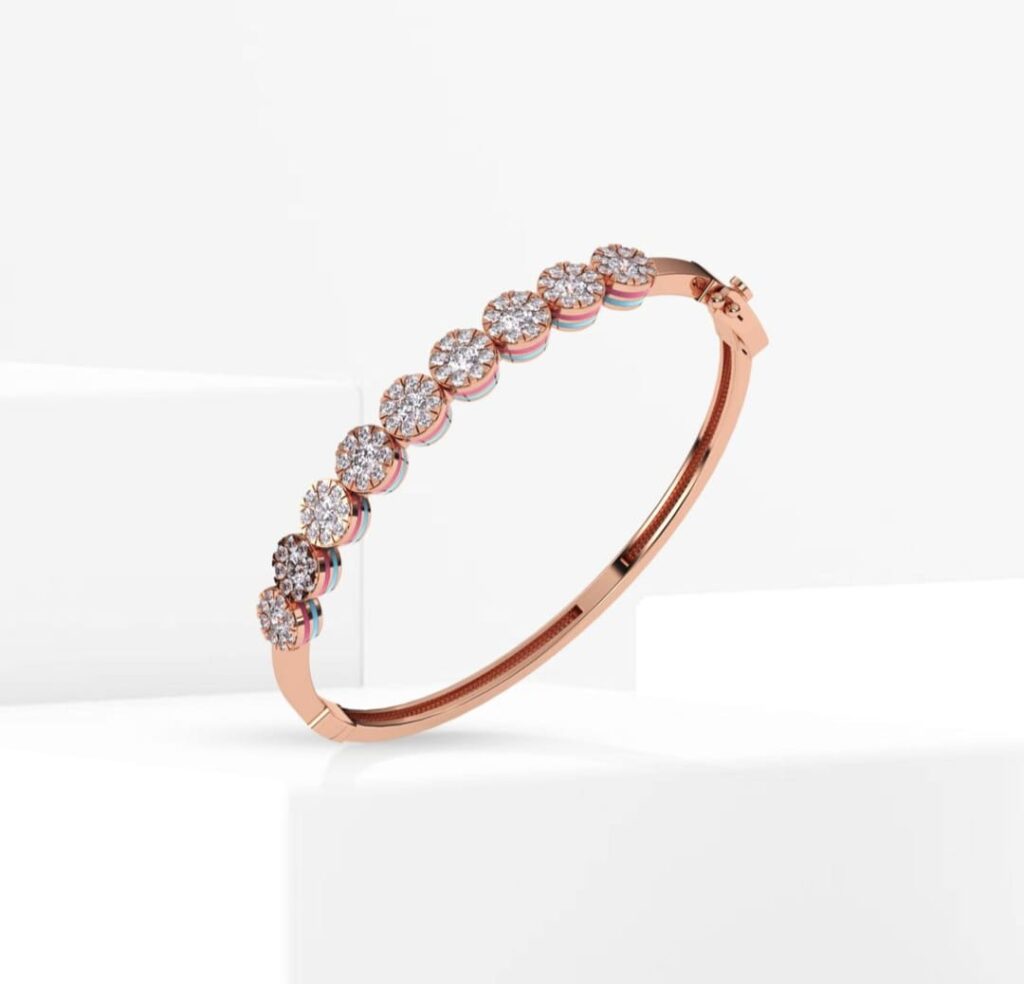
Rose Gold Jewelry
3 gold alloys comparison in five aspects
Comparative Analysis:
- Color: Yellow gold offers a classic, timeless look, while white gold provides a modern, elegant alternative. Rose gold offers a romantic and feminine touch.
- Durability: White gold and rose gold are generally more durable than yellow gold due to the addition of stronger metals.
- Maintenance: White gold may require occasional rhodium plating to maintain its luster. Rose gold may require re-plating to restore its color over time.
- Versatility: All three colors are versatile and can be paired with a wide range of gemstones and styles.
- Price: Pure gold is the most expensive, followed by 22K, 18K, 14K, and 10K. White gold and rose gold may be slightly more expensive than yellow gold due to the cost of the alloying metals.
Choosing the Right Gold Color:
The choice of gold color ultimately depends on personal preference, skin tone, and intended style.
- Yellow Gold: Flatters most skin tones and pairs well with a variety of gemstones, making it a classic and versatile choice.
- White Gold: Complements cool skin tones and adds a modern touch to any jewelry collection.
- Rose Gold: Flatters warm skin tones and offers a romantic and feminine alternative.
Beyond the Three:
While yellow, white, and rose gold are the most common colors, other variations exist, such as green gold, blue gold, and black gold. These unique colors are achieved through the addition of specific alloying metals and are often more expensive and less common.
Conclusion:
The choice of gold color is a personal one, and the best option will depend on individual preferences and style. By understanding the characteristics, composition, and comparative aspects of yellow, white, and rose gold, individuals can make an informed decision and select the perfect gold color for their jewelry needs. Whether you prefer the classic warmth of yellow gold, the modern elegance of white gold, or the romantic charm of rose gold, there is a perfect gold color to suit every taste and style.
Additional Considerations:
- Karat: The karat of gold indicates its purity, with 24K being pure gold. Higher karat gold is generally more expensive and softer, while lower karat gold is more durable and affordable.
- Rhodium Plating: White gold is often rhodium-plated to enhance its luster and prevent tarnishing.
- Color Fading: The color of rose gold may fade over time due to oxidation and require re-plating.
- Skin Tone: Consider your skin tone when choosing a gold color. Yellow gold generally flatters most skin tones, while white gold complements cool skin tones, and rose gold flatters warm skin tones.
By carefully considering these factors, you can select the perfect gold color for your unique style and preferences.
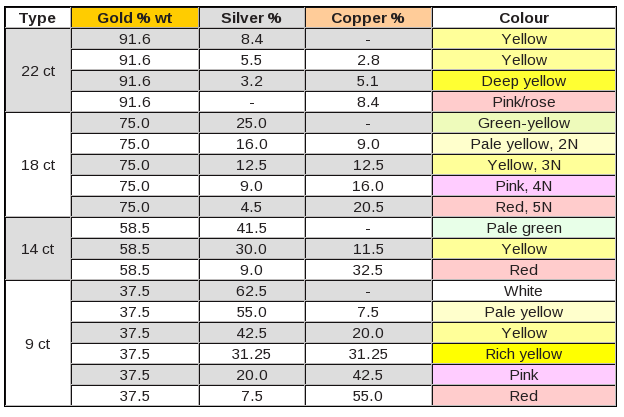
Here’s a simple comparative chart for Yellow, White, and Rose Gold:
| Feature | Yellow Gold | White Gold | Rose Gold |
|---|---|---|---|
| Base Metal | Gold + Copper, Silver, Zinc | Gold + Nickel, Palladium, Platinum | Gold + Copper |
| Color | Warm Yellow | Silvery White | Pink/Rose |
| Durability | Moderate | High (with rhodium plating) | High |
| Maintenance | Occasional polishing | Requires periodic rhodium re-plating | Minimal; color may fade over time |
| Skin Tone | Suits most skin tones | Best for cool skin tones | Flatters warm skin tones |
| Style | Classic, Timeless | Modern, Elegant | Romantic, Feminine |
FAQ section : 3 gold alloys comparison.
1. What are the main differences between yellow, white, and rose gold?
- Yellow Gold: This is the purest color of gold, mixed with metals like silver and copper to enhance durability. It has a classic, warm appearance and is often associated with traditional jewelry.
- White Gold: Created by alloying gold with white metals such as nickel, palladium, or silver, white gold has a sleek, modern look. It is often rhodium-plated to enhance its whiteness and provide a reflective surface.
- Rose Gold: Rose gold obtains its pinkish hue from a higher copper content in the alloy. It offers a romantic and vintage appeal, making it popular in various jewelry designs.
2. How does the alloy composition affect the color of gold?
The color of gold is determined by the type and proportion of metals mixed with pure gold:
- Yellow Gold: Typically alloyed with silver and copper in equal parts, maintaining its classic yellow hue.
- White Gold: Alloyed with white metals like nickel or palladium; the exact metals can vary depending on the manufacturer.
- Rose Gold: Contains a higher percentage of copper, giving it a distinctive pinkish color.
3. Is the purity of gold the same in yellow, white, and rose gold?
Yes, the purity of gold is measured in karats and is consistent across all colors. For example, 18K gold contains 75% pure gold, regardless of whether it is yellow, white, or rose.
4. Which type of gold is the most durable?
Durability depends on the metals used in the alloy:
- Rose Gold: Often considered the most durable due to its high copper content, which adds strength.
- White Gold: Also durable, especially when alloyed with nickel; however, it may require rhodium re-plating over time to maintain its luster.
- Yellow Gold: While durable, it is generally softer than rose and white gold, making it more susceptible to scratches.
5. How should I choose the right gold color for my skin tone?
- Yellow Gold: Complements warm skin tones with yellow or olive undertones.
- White Gold: Suits cool skin tones with pink or blue undertones.
- Rose Gold: Versatile and complements most skin tones, particularly flattering on neutral or slightly warm undertones.
6. Does white gold require special maintenance?
Yes, white gold jewelry is often rhodium-plated to enhance its appearance. Over time, this plating can wear off, necessitating re-plating to maintain its luster and color.
7. Is rose gold hypoallergenic?
Rose gold contains copper, which can cause allergic reactions in some individuals with sensitive skin. If you have metal allergies, it’s advisable to choose alloys that are known to be hypoallergenic.
8. How does the cost compare among yellow, white, and rose gold?
The cost is generally similar across all gold colors of the same karat. However, white gold may be slightly more expensive due to the rhodium plating process.
9. Can I mix different gold colors in my jewelry?
Yes, mixing different gold colors, known as two-tone or tri-color jewelry, is a popular trend that offers versatility and a unique aesthetic appeal.
10. How do I care for my gold jewelry to ensure its longevity?
- Regular Cleaning: Use a mild soap solution and a soft brush to clean your jewelry.
- Proper Storage: Store pieces separately to avoid scratches, preferably in a soft pouch or lined jewelry box.
- Avoid Chemicals: Remove jewelry when swimming or handling household cleaners to prevent damage.
11. Are there any cultural significances associated with different gold colors?
Yes, cultural preferences can influence the popularity of gold colors. For instance, yellow gold is traditionally favored in many cultures, while white and rose gold have gained popularity in contemporary fashion.
12. Can gold jewelry tarnish over time?
Pure gold does not tarnish; however, the metals in gold alloys can react with environmental factors, leading to discoloration. Regular maintenance can help prevent this.
13. Is it possible to change the color of my existing gold jewelry?
Altering the color of gold jewelry involves complex processes and is generally not recommended, as it can compromise the integrity of the piece.
14. How does the choice of gold color affect gemstone appearance?
The color of gold can enhance or contrast with gemstones:
- Yellow Gold: Enhances warm-colored gemstones like rubies and emeralds.
- White Gold: Complements colorless diamonds and cool-colored gemstones like sapphires.
- Rose Gold: Pairs well with pink or red gemstones, adding to its romantic appeal.
15. Are there any trends in gold color preferences?
Trends in gold color preferences can vary by region and over time. For example, rose gold has seen a resurgence in popularity in recent years, especially among younger consumers seeking unique jewelry pieces.

